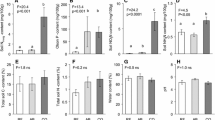Abstract
The trophic structure of a ground-dwelling insect community has been studied in the coastal zone of a salt lake in the southern forest-steppe (Novosibirsk oblast). Five contrasting habitats along a 170-m catena with an altitude drop of 1.8 m were studied. In each habitat, the soil, as well as dominant insect and plant species, were sampled: phytophages, saprophages, and predators. According to a stable-isotope analysis of carbon and nitrogen (δ13C and δ15N), phytophagous insects (the locust Epachromius pulverilentus and carabid beetle Dicheirotrichus desertus) are closely connected to their food objects and hardly migrated along the catena. Saprophages (the mole cricket Gryllotalpa unispina and earwig Labidura riparia) use various food resources; some of them (mole crickets) tend to migrate between the biotopes. Predatory beetles (carabid imagoes) can be separated into three trophic guilds: (1) highly mobile active predators, including the tiger beetles Cephalota chiloleuca and C. elegans; (2) small generalist predators of Pogonini tribe (Pogonus cumanus, P. transfuga, Pogonistes rufoaeneus, and Cardiaderus chloroticus); and (3) relatively large consumers of soil saprophages and aquatic organisms (Curtonotus propinquus and Cymindis equestris). The trophic niche overlap of different predators is partially compensated by their confinement to different habitats.
Similar content being viewed by others
References
Bespalov, A.N. and Lyubechanskii, I.I., Dynamics of abundance of ground beetles (Coleoptera, Carabidae) in fenced areas in the Cis-Altai plain (Western Siberia), Entomol. Rev., 2011, vol. 91, no. 4, pp. 420–427.
Carabidae of the World, Anichtchenko, A., et al., Eds., 2015. http://www.carabidae.org
Coll, M. and Guershon, M., Omnivory in terrestrial arthropods: mixing plant and prey diets, Annu. Rev. Entomol., 2002, vol. 47, pp. 267–297.
Fedorov, I.V., Seasonal dynamics of insect communities in fragmentary solonchak desert in Novosibirsk oblast, Evraziat. Entomol. Zh., 2013, vol. 12, no. 4, pp. 378–388.
Fedorov, I.V. and Mordkovich, V.G., Level and structure of insect diversity of new ecosystem of drained zone of the salt lake in Kulunda, Evraziat. Entomol. Zh., 2012, vol. 11, no. 4, pp. 359–371.
Goncharov, A.A. and Tiunov, A.V., Trophic chains in the soil, Biol. Bull. Rev., 2014, vol. 4, no. 5, pp. 393–403.
Hammer, Ø., Harper, D.A.T., and Ryan, P.D., PAST: Paleontological statistics software package for education and data analysis, Palaeontol. Electron., 2001, vol. 4, no. 1. http://palaeo-electronica.org/2001_1/past/issue1_01.htm
Kataev, B.M., Ground beetles of genus Harpalus (Coleoptera, Carabidae) in the world fauna: systematics, zoogeography, and phylogeny, Extended Abstract of Doctoral (Biol.) Dissertation, St. Petersburg: Zool. Inst., Russ. Acad. Sci., 2011.
Korobushkin, D.I., Role of allochthonous carbon in the energy of terrestrial invertebrate communities at different distances from the Black Sea and a freshwater lake (isotopic evidence), Russ. J. Ecol., 2014, vol. 45, no. 3, pp. 223–230.
Korobushkin, D.I., Gongalsky, K.B., and Tiunov, A.V., Isotopic niche (δ13C and δ15N values) of soil macrofauna in temperate forests, Rapid Comm. Mass Spectrom., 2014, vol. 28, no. 11, pp. 1303–1311.
Krivenko, V.G., Vodoplavayushchie ptitsy i ikh okhrana (Waterfowl Birds and Their Protection), Moscow: Agropromizdat, 1991.
McCutchan, J.H., Lewis, W.M., Kendall, C., and McGrath, C.C., Variation in trophic shift for stable isotope ratios of carbon, nitrogen, and sulfur, Oikos, 2003, vol. 102, pp. 378–390.
Mordkovich, V.G., Zoological characteristics of ordinary soils in drained zones of the salt lakes of southern Siberia, Zool. Zh., 1973a, vol. 52, no. 9, pp. 1321–1329.
Mordkovich, V.G., An order of domination of ecological groups of mesoherpetobium during seasonal development of community in Barabinsk forest steppe, Zool. Zh., 1973b, vol. 52, no. 10, pp. 1490–1497.
Otsenochnyi doklad ob izmeneniyakh klimata i ikh posledstviyakh na territorii Rossiiskoi Federatsii. Tom 1. Izmeneniya klimata. Tom 2. Posledstviya izmeneniya klimata (Assessment Report about Climate Changes and Its Consequences in Russian Federation. Vol. 1: Climate Changes. Vol. 2: Consequences of Climate Change), Moscow: Rosgidromet, 2008.
Pearson, D.L. and Mury, E.J., Character divergence and convergence among tiger beetles (Coleoptera, Cicindelidae), Ecology, 1979, vol. 60, pp. 557–566.
Ponomarenko, A.G., Early evolutionary stages of soil ecosystems, Biol. Bull. Rev., 2015, vol. 5, no. 3, pp. 267–279.
Pushkareva, T.A., Features of pedogenesis in sediments of the salt lakes of Khakassia and Tuva, Extended Abstract of Cand. Sci. (Biol.) Dissertation, Tomsk: Tomsk. Gos. Univ., 2013.
Scheu, S. and Falca, M., The soil food web of two beech forests (Fagus sylvatica) of contrasting humus type: stable isotope analysis of a macroand a mesofauna-dominated community, Oecologia, 2000, vol. 123, pp. 285–296.
Sharova, I.Kh., Zhiznennye formy zhuzhelits (Coleoptera, Carabidae) (Life Forms of Ground Beetles (Coleoptera, Carabidae)), Moscow: Nauka, 1981.
Tsurikov, S.M., Goncharov, A.A., and Tiunov, A.V., Intra-body variation and ontogenetic changes in the isotopic composition (13C/12C and 15N/14N) of beetles (Coleoptera), Entomol. Rev., 2015, vol. 95, no. 3, pp. 326–333.
Vasil’ev, O.F., Kazantsev, V.A., Popov, P.A., and Kirillov, V.V., General natural characteristics and environmental problems of Chanovskaya and Kulundinskaya lakes systems and their basins, Sib. Ekol. Zh., 2005, no. 2, pp. 167–173.
Walters, D.M., Fritz, K.M., and Otter, R.R., The dark side of subsidies: adult stream insects export organic contaminants to riparian predators, Ecol. Appl., 2008, vol. 18, no. 8, pp. 1835–1841.
Zalewski, M., Dudek, D., Tiunov, A.V., Godeau, J.-F., Okuzaki, Yu., Ikeda, H., Sienkievich, P., and Ulrich, W., High niche overlap in the stable isotope space of ground beetles, Ann. Zool. Fen., 2014, vol. 51, no. 6, pp. 301–312.
Zapadnaya Sibir’ (Western Siberia), Rikhter, G.D., Ed., Moscow: Akad. Nauk SSSR, 1963.
Zelenaya kniga Sibiri: redkie i nuzhdayushchiesya v okhrane rastitel’nye soobshchestva (The Green Data Book of Siberia: The Plant Communities, Rare and Required Protection), Koropachinskii, I.Yu., Ed., Novosibirsk: Nauka, 1996.
Author information
Authors and Affiliations
Corresponding author
Additional information
Original Russian Text © I.I. Lyubechanskii, R.Yu. Dudko, A.V. Tiunov, V.G. Mordkovich, 2015, published in Aridnye Ekosistemy, 2015, Vol. 21, No. 4(65), pp. 33–42.
Rights and permissions
About this article
Cite this article
Lyubechanskii, I.I., Dudko, R.Y., Tiunov, A.V. et al. Trophic structure of ground-dwelling insects in the coastal zone of a salt lake in southern Siberia based on the data of isotopic analysis. Arid Ecosyst 5, 222–229 (2015). https://doi.org/10.1134/S2079096115040083
Received:
Published:
Issue Date:
DOI: https://doi.org/10.1134/S2079096115040083



